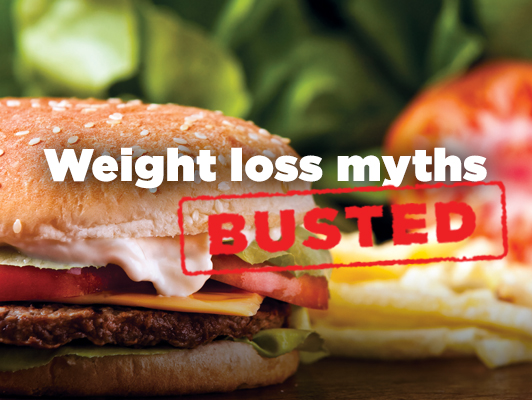Weight Loss Myths Busted
Myth 1: All carbs are bad.
Truth: Carbohydrates are the body’s main source of energy. There are three types of carbs; starches, sugars, and fiber. Starches are complex carbs and include foods like potatoes, corn, breads and cereals, and other grain products. Whole grains contain vitamins and minerals and also contain fiber. Sugars are simple carbs and include things like honey, agave, fruit and 100% fruit juice, milk, yogurt, and cheese. Fiber is a type of carb the body cannot digest and is found in fruits, veggies, whole grains, beans, nuts, and seeds. Fiber can help prevent heart disease, type 2 diabetes, and obesity. It can also help you feel fuller on fewer calories.
Tip: Aim to make half of your grains whole grains and look for the term “100 percent whole grain” on the food label.
Myth 2: There are “negative calorie” foods.
Truth: All foods have calories. While it is true that the body uses energy to digest food, there is no study that has ever demonstrated, regardless of the dietary makeup of the food, that more calories are used to digest a food than the number of calories the food contains.
Tip: While no foods have negative calories, there are lists of low calorie snacks available. Check this one out for some low calorie snack options! http://www.webmd.com/diet/obesity/get-something-for-nothing-25-nearly-calorie-free-foods
Myth 3: You should avoid eating in the evenings or close to bedtime.
Truth: Eating at night has always been viewed as a habit that leads to weight gain. Generally speaking, a calorie is a calorie, regardless of when you eat it. What leads to weight gain is simply eating more calories than you burn. According to the U.S. Department of Agriculture’s Weight Control Information Network website, “it does not matter what time of day you eat. It is what and how much you eat and how much physical activity you do during the whole day that determines whether you gain, lose, or maintain your weight.”
Tip: When eating late, pay extra attention to portions. It is easy to over eat snacks late at night. Measure out one serving and put it in a bowl. Put the rest away to avoid going back for more.
Myth 4: You should always choose the low fat versions of foods.
Truth: If your goal is to lose weight, “fat free” and “low fat” foods aren’t a magic-bullet solution. Here is what these terms actually mean:
- “Fat-free” foods must have less than 0.5 gram of fat per serving.
- “Low-fat” foods must have 3 grams of fat or less per serving.
- “Reduced-fat” foods must have at least 25% less fat than regular versions of those foods.
- “Light” foods must have either 1/3 fewer calories or 50% less fat.
Sometimes manufacturers add in other ingredients like sugar, salt, and thickeners to maintain the flavor of the product, which can add calories. In addition, if the original product is extremely high fat, while it’s true the low-fat version may be a better option that the original, it still may not be a healthy choice when trying to lose weight.
Tip: Always read the food label of these foods to check calories, type of fat, and added ingredients!
Myth 5: Skipping meals will help me lose weight.
Truth: Skipping meals may help you lose weight initially, but that strategy will fail in the long run. Skipping meals may cause you to feel extra hungry later in the day and cause you to overeat during the meals you do eat. Instead, you should aim for a long-term meal plan that includes three to six meals or healthy snacks a day, consisting of a wide variety of fruits, vegetables, whole grains, lean protein, and low-fat dairy products.
Tip: Try keeping healthy snacks in your desk or car so they are available in case you forget to pack a lunch or breakfast and are tempted to skip a meal. Veggies, fruits, or whole grain crackers are great options!
If you’re looking to reach a healthier weight ask your doctor about a prescription for wellness, or call 1-855-395-8762 to speak directly to a health coach to get started.




